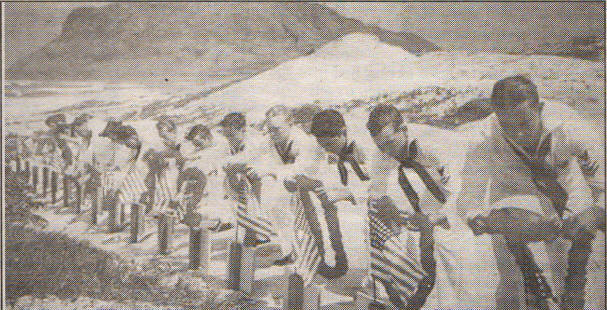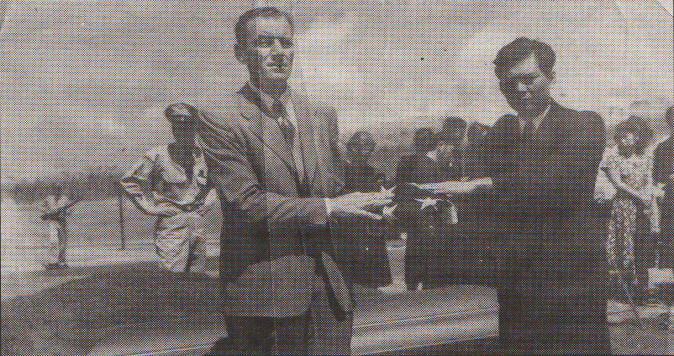Veterans Keep Memories Alive at Hawaiian 'Punchbowl' by
COL Renita Foster
For the last 15 years,
Bernard Akamine has
volunteered his services at the
"Punchbowl
Cemetery" in Honolulu, Hawaii.
And the drive there almost always reminds
him of another journey. One he made
just over 65 years ago, the day after the Japanese
attack on Pearl Harbor Dec. 7, 1941.
Called Punchbowl because of its shape, the
National Memorial Cemetery of the Pacific
lies in an extinct volcano called Puowaina (pronounced: puh-oh-why-nah),
and meaning "Consecrated Hill" or "Hill of
Sacrifice." Its name is appropriate since it's
the final resting place for 33,230 service
men and women from four wars,
beginning with the casualties from the
Pearl Harbor assault.
Identifying the dead after the battle at Pearl
Harbor was difficult. Dog tags, billfolds,
personal letters, ring inscriptions,
even tattoos were the most reliable methods.
Far worse was matching body
parts for burial. The initial ceremony
consisted of an honor guard lined up on two
sides of a large trench. The firing squad and bugler were on
the third side while three chaplains, representing
the Protestant, Catholic and Jewish
faiths, were placed on the fourth..
If a Soldier's denomination
was known, that chaplain conducted the
interment. In most cases, there was no idea
about the preferred faith so all three chaplains came forward.
A brief scripture was read, and each chaplain offered a prayer in English, Latin
and Hebrew. They were determined to
give every man in death what had been
his choice in life.
One chaplain later wrote,
"The God of the
universe heard the prayers of us all."
Akamine and co-worker,
Darwin Garrett,
arrived around. 7 a.m. on Dec. 7, 1941, at
the Wahiawa Naval Radio Station
where they were installing electrical lines.

Following Hawaiian
tradition, Sailors honor men killed during the 7 December 1941 Japanese attack
on
Naval Air Station Kaneohe, Oahu. The casualties had been buried on 8
December. This ceremony took
place sometime during the following months, possibly on Memorial Day, 31 May
1942.
Because it was Sunday, the
area was quieter
than usual. Shortly after starting work,
they heard what sounded like Army maneuvers.
The crew shrugged it off until another
worker happened to turn on his car radio and
learned Pearl Harbor was under attack.
"Jim, another employee, ran to the office
to tell the boss about the assault," said Akamine. "The boss told him
that if he wanted to go home and
drink, that was fine, he didn't have
to make up stories. It wasn't until Jim insisted that the boss come to
listen to the radio that he believed it was
true."
Akamine and his supervisor headed to
the radio station's commandant. His
reaction to the breaking news was also
one of disbelief. He even accused the men of lying until his repeated phone call
attempts all went unanswered. Once again, a
radioprovided the essential proof.
The commandant ordered all
the workers to a bomb-proof building. For
almost four hours. Akamine sat with nearly
50 civilians, Navy personnel, and
dependents in the underground facility
for protection against further attacks. Most were still in shock, and they
waited in silence.
"When nothing had happened
by noon, we were
ordered to hook up teletype machines. That was the only type of communication
working since the radios weren't
prepared yet," said Akamine. "We stayed up
all night getting them operational with no
time out for sleeping or eating."
The men were finally allowed to leave
the next afternoon, but
only for showers and
a change of clothes."
Garrett asked for
permission to check on
his brother, Robert, stationed at Hickam
Army Air Field. Accompanied by Akamine,
the two men rode in
foreboding silence, anxiously
wondering what Robert's status
might be.
When the guards refused
Garrett and Akamine entry, Garrett
pleaded with them to contact the barracks. No answer or connection could be made and the two men were ordered to leave.
Akamine continued working
on the radio station for the next two
weeks. Afterwards, he was sent to install
electricity in the mess hall. A few days later, a Caucasian officer
came by and ordered Akamine off the job
yelling, "No Japs!"
"I happen to be Nisei, a second
generation Japanese American. So I didn't
care for the remark, but I didn't let
it upset me because in my heart I
knew I was an American," said Akamine. "And the Caucasian
workers that took over did a terrible job.
The refrigerator compressors and lights burned
out. We had to eat canned food until they
were able to fix the problem. There were accusations
of sabotage, but we Niseis knew we were
not responsible because we were.
forbidden to work on that job."
A few days after Dec.
7th, Garrett received
a telegram from his mother informing
him that his brother was killed during the
Japanese attack:
Told
his brother had been buried in the
temporary cemetery at Schofield Barracks, Garrett went to the area where crosses
were still being placed into
gravesites.
There he found the cross
with his brother's
name on it. Bursting into tears,
Garrett knelt in front of it.
Garrett learned what had happened to
Robert when he was finally given access to
the barracks where his brother had
been quartered.
Bullet holes were everywhere on the
sides of the building where Robert's unit had been asleep when the attack
began.
Thunderous noise had
awakened the Soldiers.
When they ran outside to see what the
commotion was, the men were gunned down
and killed.
The 2,335 servicemen and 68
civilians that included Americans and
Japanese killed , in action, were buried in
temporary graves around the island.
After Punchbowl Cemetery
was built in 1948
and dedicated a year later, 776 casualties
ties from the Pearl Harbor attack, including
Robert, were reburied there.
Darwin Garret had left to join the Army Air
Corps, but Akamine had returned home to
Honolulu
after serving with the 100th Infantry
Battalion in Europe, and attended
Robert's graveside
committal service.
Although Robert's interment
was over half a
century ago, the memory has never left
Akamine.
That image, and the call
for volunteers at
Punchbowl for the 50th
Pearl Harbor anniversary, motivated Akamine to volunteer.
His duties include answering questions, training
new recruits, and helping visitors looking
for gravesites like Ernie Pyle's, the famous World War II correspondent
who is buried there.
There's also interest in the late Senator Spark
Matsunaga and Ellison Onizuka, the first astronaut from
Hawaii who perished in the
Challenger disaster.
Additionally, Akamine
shares stories about his friends interred
there and visits Robert as well. Every year
the 100th veterans and their families
decorate the gravesites of the Killed
in Action and those who have passed
away in recent years with floral offerings.
"Sometimes, when people
learn I served with the l00th Infantry
Battalion in Europe, they ask how I could
fight against my own brothers. I
answer, `I was and am American, fighting with my brothers and for my
country.

Harry Fox (left), who worked with
Bernard Akamine and Darwin Garret [sic], at the final burial of Robert R. Garret
[sic]
at the National Memorial Cemetery of the Pacific, also called the "Punchbowl."
Robert R. Garrett was killed on
Dec 7, 1941, during the Japanese attack on Pearl Harbor.
After the 50th anniversary, Akamine realized
that the Visitors Center was open daily, but the main office
was closed on Saturday and Sunday,
leaving visitors without any assistance on the weekends.
Akamine decided continuing to volunteer
would be a good cause for his 100th Infantry Battalion Veterans Club, especially
since their motto is "For Continuing
Service."
"Luckily, the club president agreed, and
we were able to recruit
more volunteers like the 442nd Regimental Combat Team Veterans
Club," said Akamine. "This was a real
blessing since a lot of us are aging and have
to drop out."
Akamine still remembers the bittersweet
celebration when word came on
May 2,
1945, that the war in Europe was over.
Jubilation soon changed to sorrow as the
Soldiers began thinking about those who
died and those who were severely wounded.
Aware of the sudden mood change, the
battalion chaplain called all the Soldiers together.
He explained and reassured the unit
that God had a purpose for everyone; the purpose of those who were killed
was to die for their country.
The purpose of those who survived was to look forward to
going home, starting families and careers, and rebuilding communities by being
good citizens.
“I can still hear those comforting words today,”
said Akamine. “That sermon and my work here at Punchbowl help me remember those
who died so that their sacrifices were not in vain.”
- Printed by permission. “Punchbowl
Cemetery”,
December 22, 2006, “The Monmouth Message”

